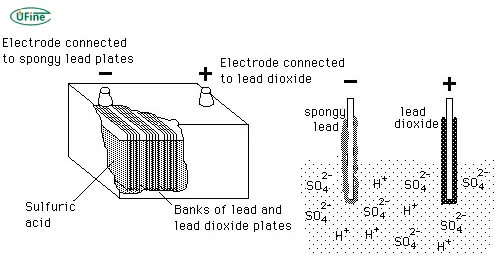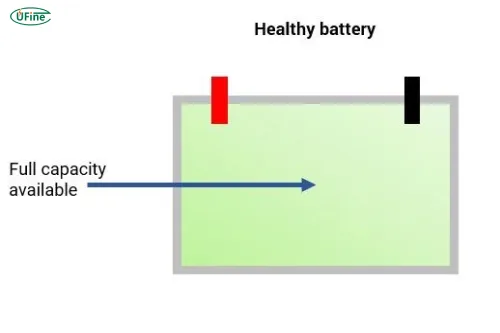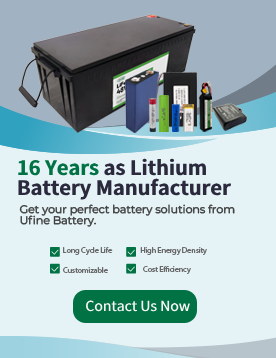
- Part 1. What is a sulfated battery?
- Part 2. What causes a battery to become sulfated?
- Part 3. What are the symptoms of a sulfated battery?
- Part 4. What is the typical voltage of a sulfated battery?
- Part 5. Can you charge a sulfated battery?
- Part 6. How do you fix or repair a sulfated battery?
- Part 7. What happens inside sulfated battery plates?
- Part 8. How to clean a sulfated battery and its terminals?
- Part 9. Can you fix a sulfated car battery at home?
- Part 10. How to prevent battery sulfation in cars
- Part 11. Quick reference table
- Part 12. Summary: Understanding and managing sulfated batteries
- Part 13. FAQs
Part 1. What is a sulfated battery?
Quick Answer: A sulfated battery is a lead-acid battery that has developed hard, crystalline deposits of lead sulfate on its internal plates. This condition prevents the normal chemical reactions that store and release energy, resulting in reduced performance, slow charging, and early battery failure.

In a healthy lead-acid battery, lead and lead dioxide react with sulfuric acid to form lead sulfate during discharge. When charging, this reaction reverses—lead sulfate converts back into active materials. However, when the battery is left undercharged or discharged for too long, lead sulfate hardens into large crystals that cannot dissolve easily. This irreversible build-up is known as battery sulfation.
In short: sulfation is the number one reason why most car batteries die prematurely.
Part 2. What causes a battery to become sulfated?
Several factors can lead to sulfation in automotive and deep-cycle batteries:
1. Frequent short trips or incomplete charging
If your vehicle’s alternator never brings the battery to a full state of charge, sulfation gradually builds up on the plates.
2. Prolonged storage without maintenance
When a battery sits unused for weeks or months, its charge drops naturally (self-discharge). At low voltage, sulfate crystals harden and become permanent.
3. High operating temperatures
Heat accelerates chemical reactions inside the battery, causing rapid crystal growth and electrolyte evaporation.
4. Chronic undercharging
Keeping a lead-acid battery below 12.4V for long periods allows soft sulfate to transform into hard, crystalline sulfate.
5. Poor maintenance or incorrect charging equipment
Using an incompatible charger or failing to perform periodic maintenance charging can also lead to sulfation.
In most cases, sulfation is a maintenance-related failure, not a manufacturing defect.
Part 3. What are the symptoms of a sulfated battery?
Recognizing sulfation early can save a battery from total loss. The following are common symptoms seen in car and deep-cycle batteries:
| Symptom | Description |
|---|---|
| Sluggish cranking or slow engine start | The battery struggles to deliver current, especially in cold weather. |
| Longer charging time | Charging takes significantly longer because the sulfate crystals block chemical reactions. |
| Inability to hold charge | The battery drains quickly even when not in use. |
| Voltage drops under load | The battery voltage appears normal at rest but collapses when starting the engine. |
| Reduced capacity | Shortened run time for auxiliary loads or accessories. |
| Distorted or swollen case (severe cases) | Excessive gassing due to overcharging or internal resistance buildup. |
If your car battery consistently measures below 12.4 volts after charging, it’s likely starting to sulfate.
Part 4. What is the typical voltage of a sulfated battery?
A healthy 12V car battery has about 12.6–12.8V at rest and reaches 14.4–14.8V during charging.
A sulfated battery, however, behaves differently:
- At rest: It may still show 12.6V, giving a false impression of full charge.
- Under load: Voltage drops quickly due to high internal resistance.
- During charging: It may climb too high (>15V) without absorbing current efficiently.
- After charging: Voltage declines rapidly, indicating the battery cannot retain energy.
This deceptive voltage behavior is why many sulfated batteries are misdiagnosed as “good” when tested superficially.
Part 5. Can you charge a sulfated battery?
Yes, you can attempt to charge a sulfated battery, but success depends on the extent of sulfation. Soft sulfation—formed recently—can sometimes be reversed. Hard sulfation—formed over months—is usually permanent.
Recommended Charging Method
- Use a smart charger or desulfating charger
- Choose a model with pulse charging or reconditioning mode.
- Start with a normal full charge
- Bring the battery to 100% SOC (state of charge) before desulfation.
- Apply a low-current, high-voltage conditioning phase
- Around 15.5–16.0V for 12V batteries, at 2–5% of the rated amp-hour capacity.
- Maintain temperature control
- Keep battery temperature below 50°C (122°F).
- Finish with a float or maintenance charge
- Once desulfation stabilizes, keep it on a 13.2–13.6V trickle mode to prevent relapse.
If the battery overheats or vents gas excessively, stop immediately—severe sulfation may make it unsafe to recover.
Part 6. How do you fix or repair a sulfated battery?
Repairing a sulfated battery means reversing or minimizing sulfate build-up and restoring as much active material as possible.
Step-by-Step Sulfated Battery Repair Guide
- Diagnosis – Confirm sulfation using a load test or conductance meter. Low CCA and quick voltage drop indicate sulfation.
- Pre-charge inspection – Check electrolyte levels (for flooded batteries) and top up with distilled water if needed.
- Full standard charge – Recharge using a compatible automotive charger until current drops near zero.
- Desulfation mode – Run the charger’s conditioning or equalization cycle for several hours.
- Rest and retest – Let the battery cool for 12 hours, then measure voltage and perform a capacity test.
- Reconditioning cycles – Repeat the desulfation phase 2–3 times if improvement is seen.
- Maintenance – Keep on a float charger if the vehicle is stored long-term.
Can Every Sulfated Battery Be Repaired?
No. If the sulfate crystals have hardened for months or caused physical plate damage, repair will have minimal effect. In such cases, replacement is the best option.
Part 7. What happens inside sulfated battery plates?
Inside every lead-acid battery are positive plates (lead dioxide) and negative plates (sponge lead) submerged in sulfuric acid. When sulfation occurs:
- The plates develop dense lead-sulfate layers that block chemical reaction zones.
- The electrolyte becomes weaker because sulfuric acid is trapped inside the crystals.
- The battery’s internal resistance rises, reducing available current.
- In severe cases, active material flakes off, shorting cells or distorting the case.
The result: The battery’s effective capacity drops dramatically, and energy cannot flow efficiently.
Part 8. How to clean a sulfated battery and its terminals?
Sulfation mainly affects the internal chemistry, but external maintenance also plays a key role in performance.
Cleaning the Terminals and Case
- Disconnect the negative cable first, then the positive.
- Mix baking soda and water (1:6 ratio) to neutralize corrosion.
- Use a brush to scrub terminals and clamps until shiny.
- Rinse with clean water and dry thoroughly.
- Reconnect positive first, then negative.
- Apply a protective grease or terminal spray.
Internal Cleaning (Desulfation)
The only safe method for internal cleaning is controlled electrical desulfation using a charger. Never open a sealed or maintenance-free battery to “scrape” the plates.
If the battery is heavily sulfated or swollen, do not attempt repair—it should be replaced safely.
Part 9. Can you fix a sulfated car battery at home?
In many cases, yes—light sulfation can be reversed with a smart charger and patience. However, the success rate depends on:
- Battery type: Flooded batteries are more recoverable than sealed AGM types.
- Sulfation duration: Weeks-old crystals are easier to dissolve than those aged for months.
- Maintenance habits: Regular float charging prevents recurrence.
If your car battery repeatedly fails after charging, replacement is the safer and more economical option.
Part 10. How to prevent battery sulfation in cars
Prevention is far easier than repair. Follow these best practices:
- Drive your car long enough for the alternator to fully recharge the battery.
- Use a battery maintainer or trickle charger during long storage.
- Keep terminals clean and tight to avoid voltage drops.
- Store the battery in a cool, dry environment.
- Avoid deep discharges — keep voltage above 12.4V whenever possible.
- Periodically check electrolyte levels (for non-sealed batteries).
A properly charged battery rarely sulfates. Consistent maintenance is the key to longevity.
Part 11. Quick reference table
| Condition | Voltage (12V battery) | Action |
|---|---|---|
| Fully charged | 12.6–12.8V | Normal operation |
| Slight sulfation | 12.3–12.5V | Recharge immediately |
| Deep sulfation | <12.0V | Desulfation charging needed |
| Severe sulfation | <11.8V | Replacement recommended |
Part 12. Summary: Understanding and managing sulfated batteries
A sulfated battery is the result of chemical imbalance and neglect. Once sulfate crystals harden, they obstruct the battery’s ability to store and deliver energy.
To summarize:
- Causes: undercharging, heat, storage, poor maintenance.
- Symptoms: weak starts, rapid discharge, false voltage readings.
- Fixes: controlled desulfation charging, reconditioning, and monitoring.
- Prevention: keep fully charged, avoid long inactivity, maintain clean terminals.
By understanding sulfation and applying preventive care, car owners can extend battery life, improve starting reliability, and reduce replacement costs.
Part 13. FAQs
Does driving longer trips help prevent sulfation?
Yes. Long drives allow the alternator to fully recharge the battery, minimizing partial-charge sulfation.
Can AGM or gel batteries sulfate too?
Yes, although at a slower rate. Sealed batteries are still vulnerable to sulfation from chronic undercharging.
How long does desulfation take?
Typically 12–48 hours depending on severity and charger type. Heavily sulfated batteries may require several cycles.
Is Epsom salt a good sulfation fix?
Not recommended. While some claim it helps, it can alter electrolyte chemistry and damage modern batteries.
Should I replace a sulfated battery if it still starts my car?
If it struggles in cold weather or loses charge quickly, replacement is wise. Continuing to use a sulfated battery may stress your alternator.
Related Tags:
More Articles

100AH Golf Cart Battery Life: How Long Can It Last?
Wondering about your 100AH golf cart battery's lifespan? Find out what affects its longevity and how to keep it running longer. Read now!
What Is a Battery Disconnect and Why You Should Use One?
Learn how a battery disconnect switch prevents power loss, improves safety, and extends battery life for cars, RVs, boats, and solar systems.
Do Car Battery Testers Really Work Accurately?
Discover how car battery testers work, their accuracy levels, and which type gives the most reliable results for your vehicle.
How Long Does a 22NF Battery Last and What Does It Mean?
Learn what 22NF means, its size, specs, types, and lifespan. Find the best 22NF battery for your vehicle or equipment with expert guidance.
The Complete Guide to 4D Batteries: Size, Specs, Price & Lifespan
Learn what a 4D battery is, how it works, specs, size, and price. Compare AGM vs lithium 4D batteries and find where to buy them safely.





